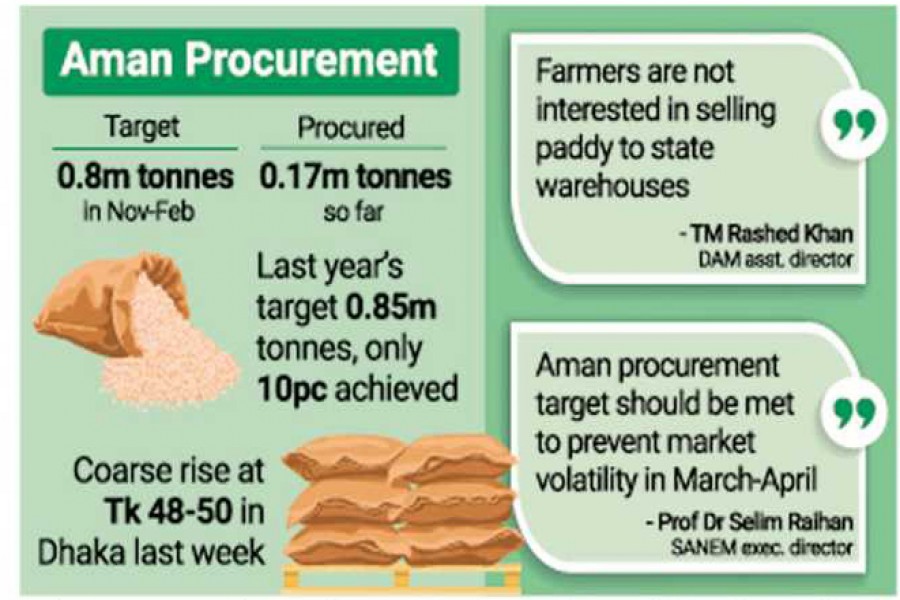The government's foodgrain procurement during Aman season from domestic sources suffers a setback again this year amid an uptrend in the price of the staple in the mainstream market.
The Directorate General of Food (DGoF) has so far bought only 19 per cent of the targeted 0.8-million tonnes of foodgrain between November and December.
Only the next 10 weeks are left to purchase the remaining 81 per cent to meet the February deadline.
It has been able to buy only 8,190 tonnes of paddy and 0.16 million tonnes of rice against a target of 0.3 million and 0.5 million tonnes respectively.
Coarse variety of Aman rice is being traded at Tk 40-43 a kg and that of paddy at Tk 26-27 a kg in rice hubs this peak harvesting season.
But the government's procurement rate is Tk 40 (rice) a kg and Tk 27 (paddy) a kg respectively, according to Department of Agricultural Marketing (DAM).
DAM asst director TM Rashed Rashed Khan says farmers are not interested in selling paddy to state warehouses for almost the same price in the village market.
He said it would take another Tk 2.0 a kg to bring paddy to public warehouses for which they are avoiding direct trade with the government.
Millers are giving rice to the government at a rate almost similar to their production costs, says Mr Khan.
Last year, Aman procurement was a fiasco as only 85,000 tonnes of rice and paddy could be bought against a target of 0.85-million tonnes, reveals the directorate.
DGoF director (procurement) Md Raihanul Kabir says the target for paddy procurement can hardly be achieved amid the current higher prices of the item in the mainstream market.
"The government intends to give farmers profits through buying paddy directly. As they are already getting lucrative price in the market, our target is rice procurement."
Mr Kabir says 0.16-million tonnes out of 0.5-million tonne rice have been bought and the directorate is hopeful of meeting the February 2022 target.
Asked, he says: "We can meet the demand for the government's safety-nets until June 2022 with the current stock as import through the government channel is on for handsome supply to government warehouses."
Public warehouses have currently 1.68-million tonnes of foodgrain stock, including 1.4-million tonnes of rice.
South Asian Network on Economic Modeling (SANEM) executive director Prof Dr Selim Raihan suggests that Aman procurement target be met to prevent any market volatility during the March-April period.
Aman comprises 37-38 per cent of the total rice output and rice production growth has been depending on Aman for the past five years in the country, he says.
Aman season is the major source for coarse rice, especially the trans-boundary variety like Swarna.
Local procurement aside, Dr Raihan says, private-sector import can keep a sound supply in the market during this pandemic when a vast population has witnessed decline in their income.
The private sector could bring only 0.25-million tonnes this fiscal year as they were allowed for 1.0-million tonnes only for poor preparations, he pointed out.
Meanwhile, the rice import stood at 0.85-million tonnes this fiscal so far, including the government's import of 0.5-million tonnes.
According to the Trading Corporation of Bangladesh, coarse rice prices have recently hiked by Tk 2.0-3.0 a kg in Dhaka as sold at Tk 48-50 a kg on Monday.


